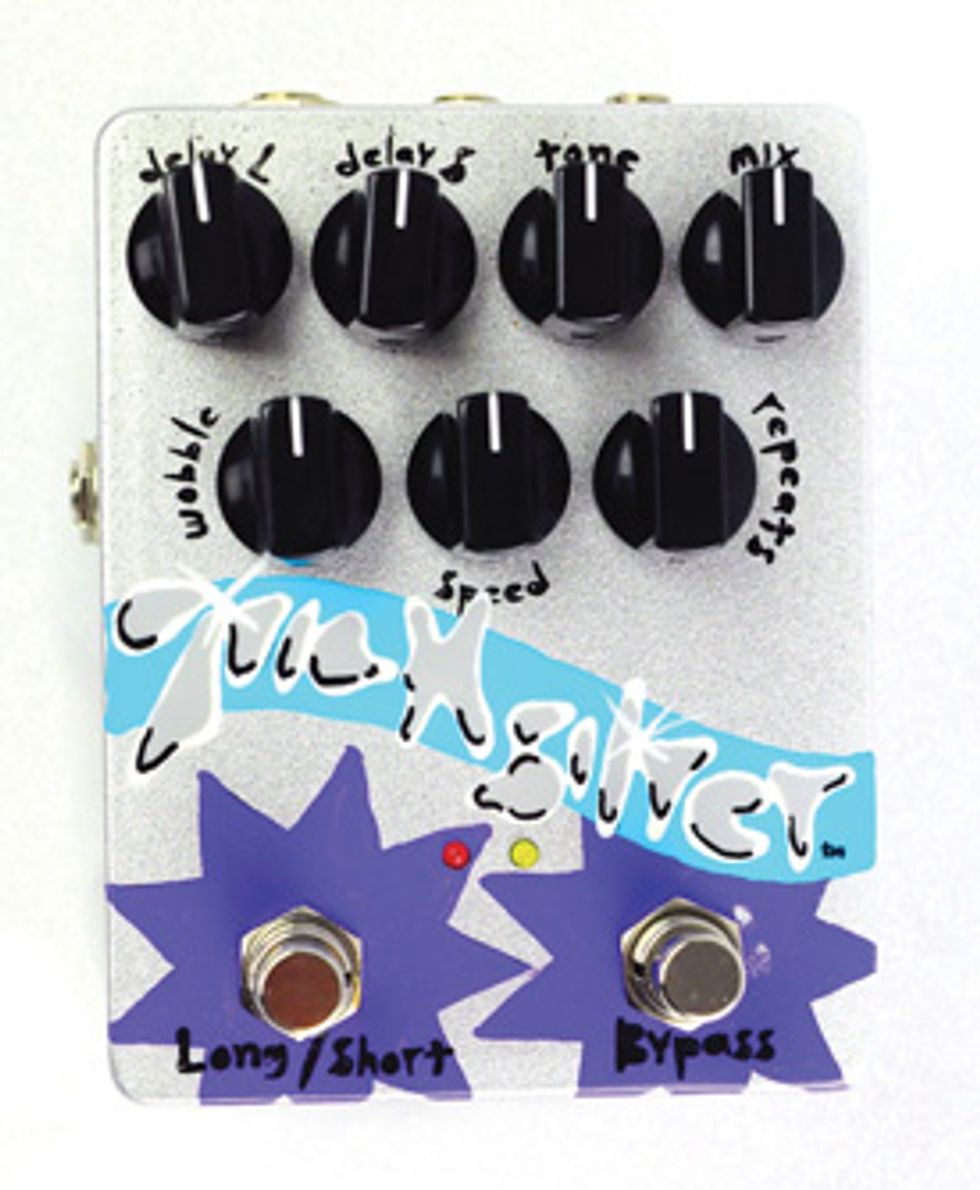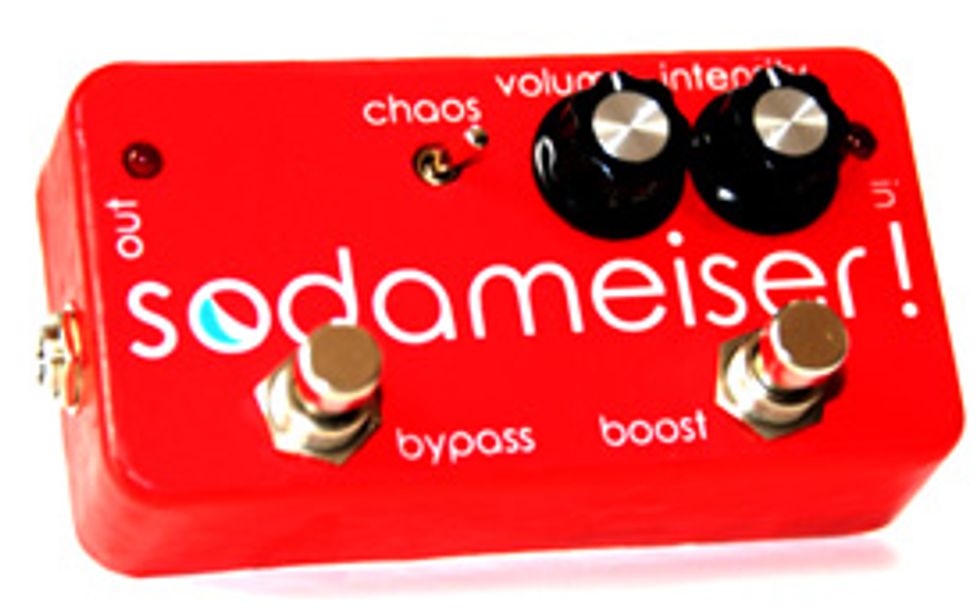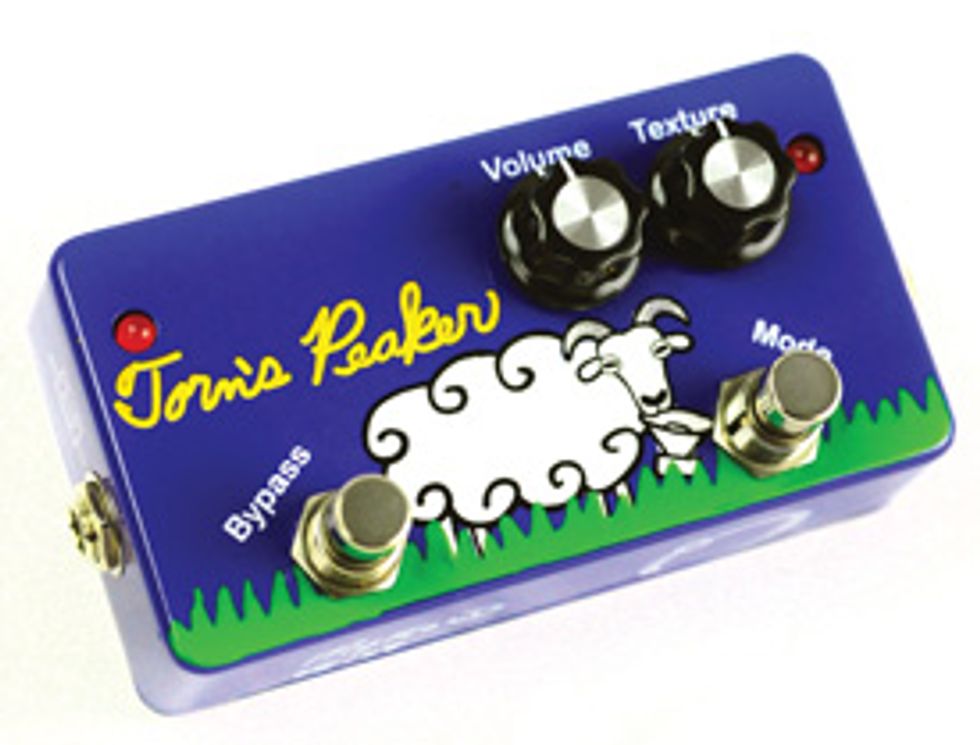OohLaLa Manufacturing is a Minneapolis based company founded by Amada Marquez. The company’s mission is to help small effects designers bring their creations to a larger audience. Currently, OohLaLa carries the creations of three designers, Lorren Stafford of Black Box Effects, Devi Ever of Effector 13 and Bruce Bennett, legendary designer and maker of the Brown Sound pedal. Don’t let the name OohLaLa or the fuzzy animal “pedal pouches” fool you, these pedals mean business. Hand built and hand painted using water-soluble inks and lead-free solder, OohLaLa offers a unique line of guitar effects that are also earth friendly. The effects have metal chassis, true bypass, and run on either a 9-volt battery or standard Boss-style DC adapter.
 | |
| Download Example | |
The Quicksilver is a very versatile pedal with plenty of options for almost any style of music. It offers 7 knobs: Delay Long, Delay Short, Tone, Mix, Wobble, Speed and Repeat. There are two footswitches: one bypass, and one that switches between Long and Short Delay. There are two small LEDs: red for Long Delay, yellow for Short Delay. Neither LED will light when the pedal is in bypass mode. You are provided with a standard in/out, expression pedal input, and an effects loop, which processes the feedback loop through external devices. The Wobble controls the amount of modulation going to the delay time. The Tone knob adjusts the tone of the delay signal— counterclockwise for a darker analog delay, and clockwise for a brighter tape delay.
When I first plugged into this pedal, I tried out the Long Delay option with the following settings: Delay Long at 2 o’clock, Tone at 10 o’clock, Mix at 2 o’clock, Wobble and Speed at 7 o’clock, and Repeat at 5 o’clock. I was treated to a healthy dose of long, drawn-out delay, and to my surprise, no out-of-control feedback from repeat build up—the notes just trailed off in the distance. Turning the speed knob up, the waves became faster, building over the slow churning waves. With the Short Delay at 2 o’clock, I backed off on the Repeat knob to 2 o’clock and turned the Wobble up to 10 o’clock to add some modulation. It was still a bit dark, so I turned the tone knob clockwise to brighten up the tone, to get a tight slapback-style delay. Using a telecaster, I achieved an icy chorused twang, with a roomier sound.
The effects loop allows you to route other effects such as fuzz, volume pedals, or delays, so that as the delay repeats, the sound becomes increasingly processed as the signal is routed through the other units. For the test, I tried out my Ernie Ball Jr. volume pedal and my Line 6 DL4. I found that I could control the ratio of dry signal to saturated signal using the volume pedal without the loss of any volume. Through the DL4 I was able to combine two different delays to create some bizzare effects. Using the reverse delay of the DL4 combined with the slapback delay of the Quicksilver, I achieved a slower build up of notes with a huge sound.
It’s worth mentioning that if the Quicksilver is in bypass mode, the pedals you run through its effect loop chain are unavailable, so players may want to use some expendable pedals in the chain. My only qualm with this unit is the absence of a Tap Tempo. Some players who are used to tapping out the delay speed on the fly may try using the expression pedal input feature, which allows you to adjust the delay speed. I didn’t have an expression pedal on hand to try this out, but I’m sure it would take some getting used to. I would recommend the Quicksilver to any guitarist or synth player looking for a great sounding analog and tape-style delay.
Buy if...
you're looking for a great sounding analog and tape-style delay.
Skip if...
you want a delay pedal with tap tempo.
Rating...
MSRP $475 - OohLaLa Manufacturing - oohlalamanufacturing.com |
 | |
| Download Example | |
The Soda-Meiser appears to be a basic fuzz pedal, but what it may lack in features it makes up for in all-out fuzz heaven. In heavy competition with the infamous Big Muff, this pedal is a lot more fun to play, with better harmonics to boot. The pedal layout is simple: you get two footswitches for Bypass and Boost, a Volume knob, Intensity knob, Chaos switch (it means what it says), and two big, bright LEDs, for Bypass and Boost. My favorite setting on this pedal was with the Intensity set at 2 o’clock without the boost; volume was adjusted according to the room. The intensity knob adjusts the amount of signal going to the fuzz circuit, similar to the sustain knob on a Big Muff. The Soda-Meiser provides amazing sustain— chords just droned on forever. The pedal also has a smooth bass response.
The mids sound great as well, but there is a roll off on the high frequencies. This caused a loss of clarity in my overall tone at lower volumes, but once I got the chance to turn the amp up loud, the highs returned. Turning the knob all the way clockwise gives you a scrambled sound, and total fuzz chaos. The boost pedal acts as an oscillator and is noisy but can provide some great fuzzed-out leads, comparable to an octave fuzz. Flipping the chaos mode switch, only the high notes survive—and forget about chords, they just break up in the sonic cruelty. Also, it is fair to note that when the boost switch is activated there is a loss in volume. The manual says adjust accordingly. In a live situation this may be a bit cumbersome for many players, so I would advise using a boost, compressor, or EQ pedal to bring the volume back up. The Soda-Meiser has the Big Muff sound, with harmonics and subtle nuances that remind me of the early Rat pedals. Fans of big, fuzzed-out stoner rock sound will love the Soda-Meiser.
Buy if...
just buy it! Best fuzz pedal I have ever heard for guitar and bass!
Skip if...
you don't like fuzz.
Rating...
MSRP $225 - OohLaLa Manufacturing - oohlalamanufacturing.com |
 | |
| Download Example | |
The Torn’s Peaker, another great play on words, is also a fuzz pedal, which is grittier overall compared to the Soda-Meiser. By design, the bass response isn’t very smooth; low chords tend to break up, but the midrange provides the clarity missing in the Soda-Meiser. It provides the same amount of features, minus the chaos switch—so you get Volume and Texture knobs, a Bypass switch and Mode switch, plus two huge LEDs to let you know when the circuits are active. The Texture knob actually acts more as a fuzz shaper than a Tone knob. Extreme right offers smooth harmonic textures, while the extreme left offers a fuzzed-out crunchy sound. The middle is fairly standard fuzz that’s still a bit on the crunchy side.
I found myself liking the crunch of this pedal with the Texture knob once again at 2 o’clock and the volume adjusted accordingly to room volume. I was able to get a good vintage crunch with plenty of note definition. I usually run my clean a little dirty, and this pedal would make a great overdrive when needed. Switching the mode will get you oscillating fuzz like the Soda-Meiser, but ultimately more static and destructive. Be warned that you’ll get a lot of background noise between notes, which can either be cool or a bit annoying. This effect does work well for some synth-like discordant leads. I found that backing off my volume pedal helped dissipate some of the noise. Some players may prefer to use a noise gate with the Torn’s Peaker, so as not to let all that noise get out of hand. Some may just let it ride. Buy if… you want a pedal to pull double duties: both fuzz and overdrive.
Buy if...
you want a pedal to pull double duties: both fuzz and overdrive.
Skip if...
you are looking for a richer fuzz, then buy the Soda-Meiser.
Rating...
MSRP $225 - OohLaLa Manufacturing - oohlalamanufacturing.com |
The Final Mojo
OohLaLa is manufacturing some very imaginative effects boxes, with some not-so-standard features. These pedals took a lot of experimenting, but after some tweaking I was able to find some useful and inspiring tones. Stoner Rock, Doom, Drone & Noise guitarists unite— these stomp boxes will inspire you to create some unique guitar tones. If you’re looking for pedals that are “off the beaten path” you will want to check out this line of effects.







![Rig Rundown: Russian Circles’ Mike Sullivan [2025]](https://www.premierguitar.com/media-library/youtube.jpg?id=62303631&width=1245&height=700&quality=70&coordinates=0%2C0%2C0%2C0)

















